How to Activate Shopify Store? 12 Simple Steps
Summer Nguyen | 12-12-2023
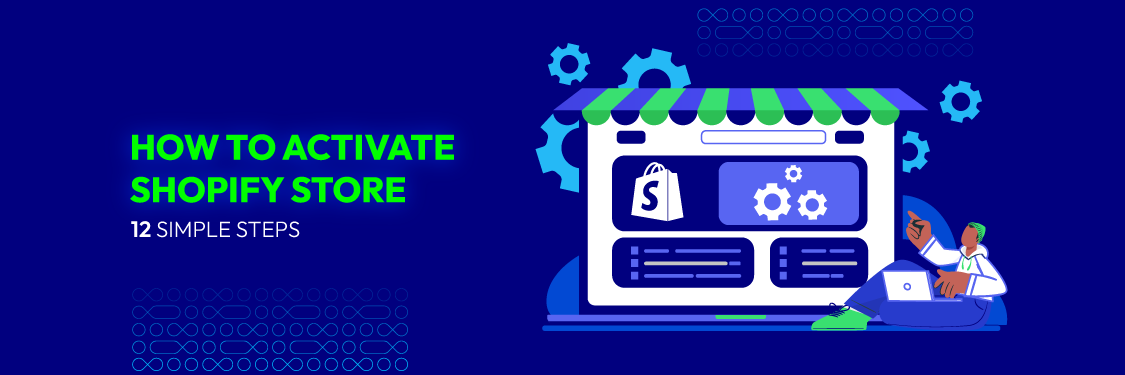
First time getting to know the Shopify platform? Looking for a comprehensive guide to a successful Shopify store? Don’t worry, we have got you covered!
Stop by this article to discover how to activate your Shopify store. We promise this will guide you to a successful store!
What is a Shopify store?
Shopify is a digital commerce platform that empowers individuals and businesses to create and manage online stores, with impressive Shopify statistics showcasing its widespread adoption and success. It provides a user-friendly interface coupled with a diverse set of tools. to help users set up and customize their online storefronts without requiring extensive technical knowledge.

Key features of a Shopify store include:
- Storefront Customization: Users can choose from a range of customizable templates to design the look and feel of their online store. Customization options include branding, colors, fonts, and more.
- Product Management: Shopify makes it easy to add and organize products, including details such as images, descriptions, pricing, and inventory tracking.
- Payment Processing: Shopify integrates with various payment gateways, allowing merchants to accept credit card payments, digital wallets, and other online payment methods.
- Order Management: Individuals can monitor and oversee customer orders, view order histories, and generate notifications.
- Security: Shopify provides secure hosting and protects transactions and customer data through SSL encryption.
- Mobile Responsiveness: Shopify stores are designed to be mobile-friendly, allowing customers to browse and make purchases from smartphones and tablets.
- App Store: Shopify provides an expansive App Store that provides an extensive array of applications and plugins to extend the platform’s functionality. These apps can add features like social media integration, marketing tools, analytics, and more.
- Hosting and Security: Shopify handles hosting, security, and server maintenance, allowing users to focus on building and running their online businesses.
- SEO Optimization: Shopify includes tools to assist in optimizing online stores for search engines, simplifying the process for potential customers to discover and visit the site.
- Support and Community: Shopify provides customer support and maintains a vibrant community where users can seek assistance, share experiences, and learn from others.
Overall, Shopify simplifies creating and managing an online store, expanding its accessibility to a broad audience of individuals and businesses looking to establish an online presence and sell products or services on the Internet.
How to activate a Shopify store?
Make sure your payment gateways are running properly
Payment gateways act as the secure bridge facilitating transactions between your Shopify store and your customers’ banks. A malfunctioning payment gateway means lost sales, frustrated customers, and potential damage to your store’s reputation.
- Test mode: Most payment gateways offer a testing or “sandbox” environment. Place several test orders, simulating both successful and unsuccessful transactions, using test payment details. This verifies integration and helps you understand error messages.
- Small live transaction: If possible, consider processing a small live transaction (perhaps to yourself or a trusted friend). This tests the entire end-to-end flow in a real-world scenario.
- Check Your Credentials: Double-check that API keys, secret keys, or other credentials provided by your payment gateway are entered correctly within your Shopify settings. Minor typos can prevent successful transactions.
- Verify Account Status: Ensure your account with the payment gateway is fully approved and active. Some may have verification steps or limitations for new accounts.
- Supported Currencies and Payment Methods: Confirm your chosen payment gateway aligns with the currencies you want to accept and the payment methods (credit card, PayPal, etc.) you wish to offer customers.
- Region and Restrictions: Be aware of potential geographic restrictions for certain payment gateways. Verify that your gateway operates in the regions where you plan to sell.
If customers encounter errors during checkout, ensure the error messages displayed are informative (not just generic “payment failed” messages). Guide them on how to proceed or provide contact information for assistance. Shopify’s support team can assist with basic payment gateway questions and integration issues.
Check your Shopify plan and domain name
Your Shopify store cannot go live without an active, paid subscription to one of Shopify’s pricing plans. During the activation process, you’ll choose the plan that best suits your store’s needs. If you’re still on Shopify’s free trial, keep in mind that activating your store by selecting a paid plan will end the trial period.
Carefully consider the features included in each Shopify plan (e.g., transaction fees, number of staff accounts, reporting capabilities) to ensure they align with your business needs and growth projections.
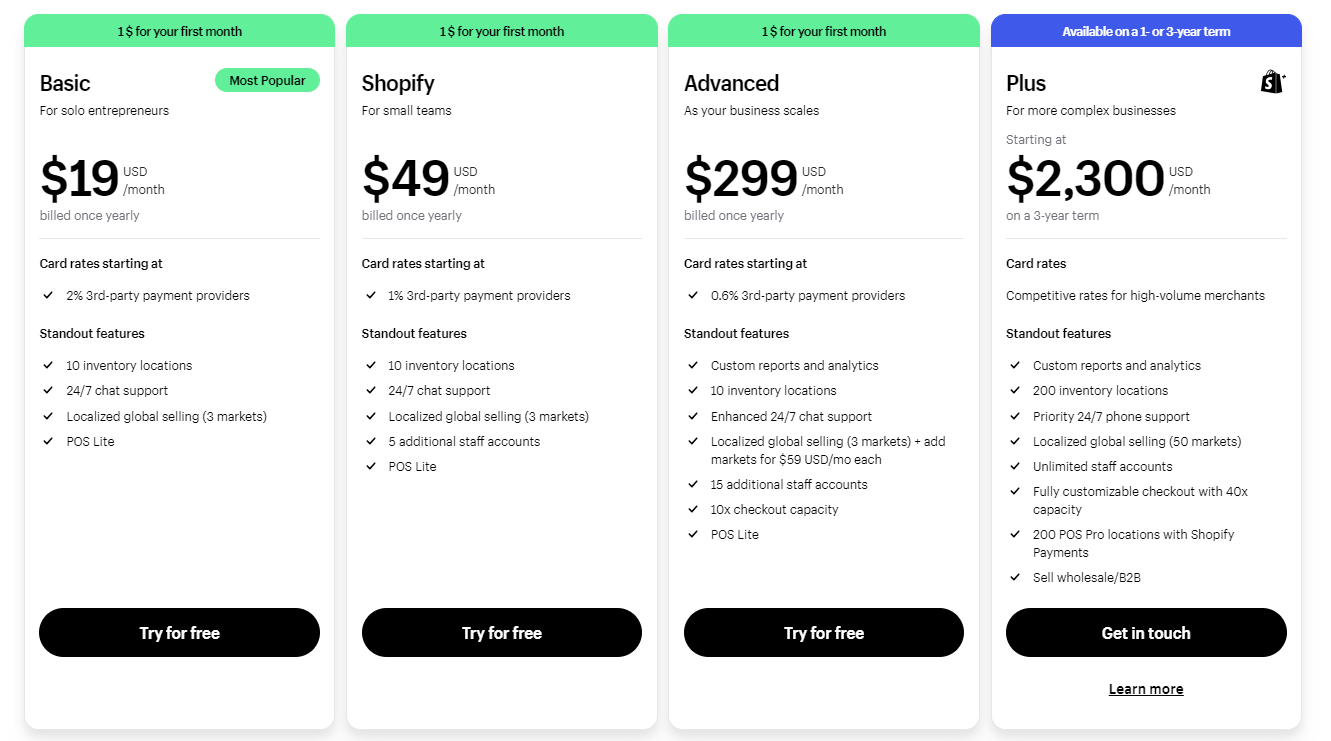
Disable store password
To make your store activated and accessible, you need to disable the default password on your store. Here’s a detailed breakdown of how to do it in two ways:
Method 1: Using the Shopify Admin
- Log In: Head to the Shopify admin panel and log in using your account credentials.
- Navigate to Online Store: In the left-hand side navigation menu, locate and click on the “Online Store” section.
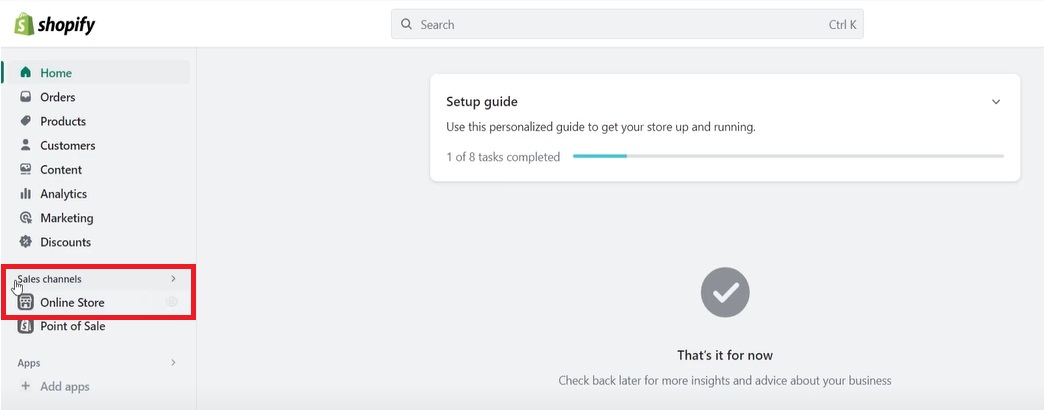
- Access Preferences: Within the “Online Store” options, find and click on “Preferences.” This will open a page with various settings related to your storefront’s presentation.
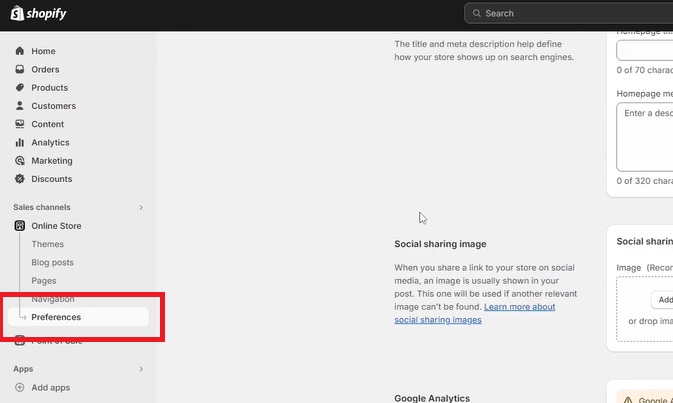
- Disable Password Protection: Look for the “Password protection” section. There will likely be a checkbox labeled “Enable password” or a similar option. If you haven’t choose a plan, you need to choose one on this step.
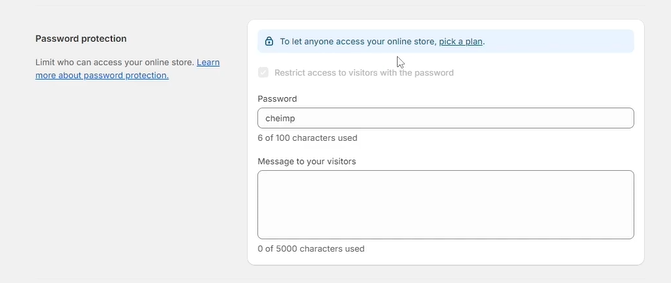
- Uncheck and Save: Uncheck the “Enable password” checkbox to disable password protection for your store. This ensures anyone can visit your store without needing a password.
Method 2: Using Themes Section (if applicable)
- Log In and Go to Themes: Following the steps above, log in to your Shopify admin and navigate to the “Online Store” section. Within “Online Store,” click on the “Themes” option. This will display your store’s theme settings.
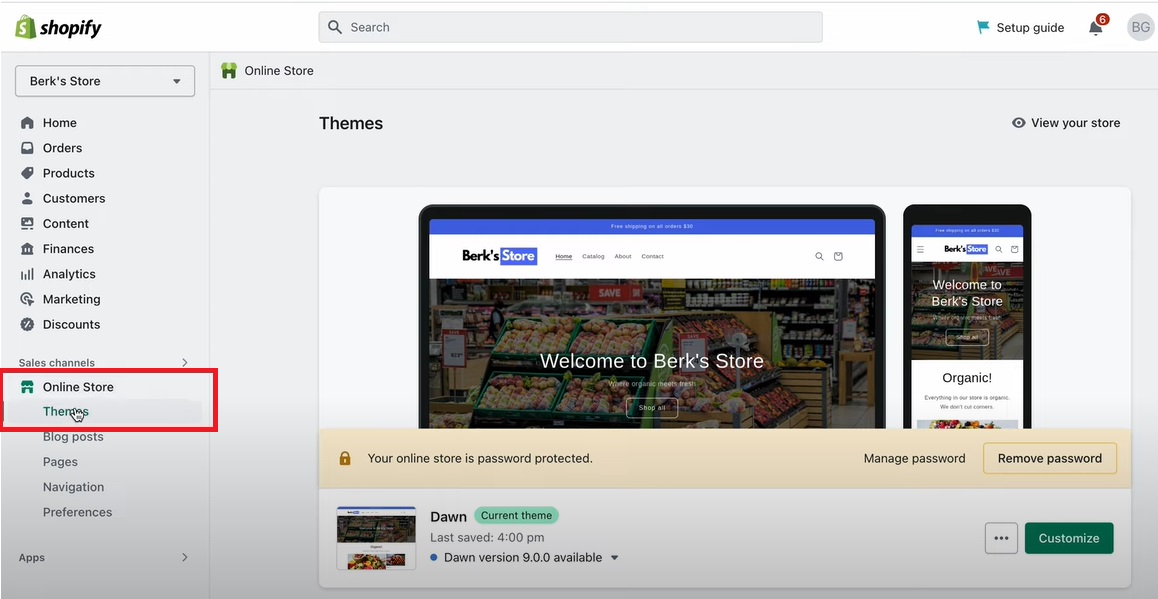
- Check for Password Banner: On the theme page, look for a banner or notification that says something like “Your online store is password protected.” If you see this message, it indicates password protection is currently enabled.
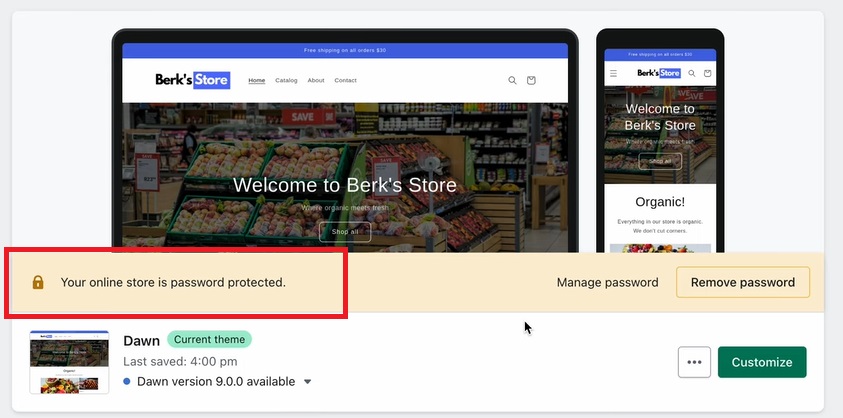
- Click to Remove Password: If the banner is present, you may see a button labeled “Remove password” or a similar option. Click on this button to disable password protection.
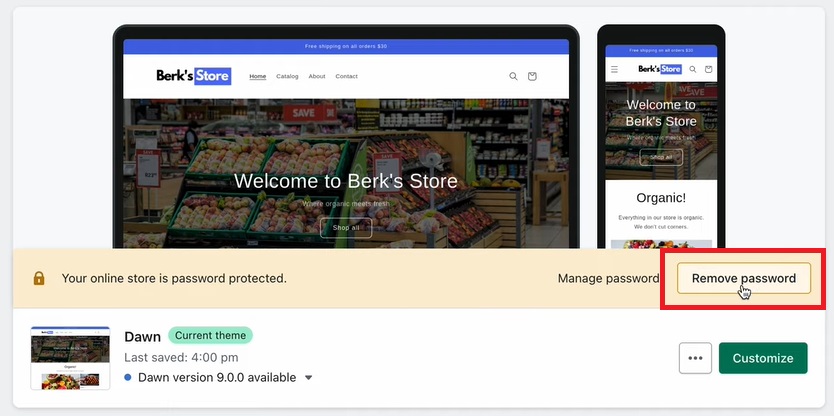
- Confirmation: A confirmation message might appear, prompting you to save the changes. Confirm the action to disable password protection.
8 Tips to prepare before go live your Shopify store
Consider using these tips before publish your Shopify store:
1. Optimize page load speed
Optimizing page load speed is integral when it comes to activate Shopify store. A fast-loading website significantly improves the overall user experience, reducing bounce rates and encouraging visitors to explore more pages.
Speed is a crucial factor in online shopping, influencing customer satisfaction and conversion rates. Google and other search engines also prioritize fast-loading websites in search results, contributing to better visibility and SEO rankings.
In the competitive world of e-commerce, where attention spans are short, a swift and responsive website is essential for retaining customers, fostering trust, and ultimately driving successful transactions, making it a key component of effective Shopify store management.
2 . Mobile responsiveness
There is an increasing number of consumers who use mobile devices for online shopping. As a result, mobile responsiveness is essential when activating the Shopify store. A mobile-friendly design ensures that your store provides a seamless and visually appealing experience across a variety of devices, including smartphones and tablets.
With mobile traffic becoming a significant portion of e-commerce, a responsive design enhances accessibility, encourages longer engagement, and reduces bounce rates. Google also takes into account mobile-friendliness when determining search rankings, impacting your store’s visibility in search results.
By prioritizing mobile responsiveness, Shopify store owners can effectively cater to a broader audience, enhance user satisfaction, and stay competitive in the dynamic landscape of online retail.
3 . Test the checkout process
The checkout stage is a critical point in the customer journey, directly impacting conversion rates and customer satisfaction. For this reason, you shouldn’t neglect regular testing for the checkout process when it comes to activate Shopify store.
By consistently testing the checkout process, you can recognize and resolve any potential issues, such as glitches, errors, or confusing steps that may impede a smooth transaction. A seamless and intuitive checkout process reduces friction, encourages customers to complete their purchases, and minimizes cart abandonment.
This proactive approach ensures that your Shopify store provides a user-friendly and efficient purchasing experience, contributing to higher customer retention rates and sustained business success.
4 . Security and data protection
Security and data protection directly impact customer trust and the overall integrity of the business. E-commerce transactions involve sensitive customer information, including personal details and payment data.
A robust security infrastructure, including encryption and secure connections, safeguards against potential breaches and protects customers from identity theft or fraud.
Demonstrating a commitment to data protection not only complies with legal and industry standards but also fosters trust among customers, encouraging them to share their information and make purchases with confidence.
In a time when online privacy is a notable concern, prioritizing security establishes a foundation for a resilient and reputable Shopify store, ultimately contributing to sustained customer loyalty and positive brand perception.
5 . Customer support and communication
Customer support and communication have a huge impact on customer satisfaction, loyalty, and the overall reputation of the business. Responsive and effective customer support builds trust, addressing concerns promptly and ensuring a positive shopping experience.
Clear communication regarding product details, shipping information, and any potential issues helps manage customer expectations and reduces the likelihood of disputes. Moreover, positive customer interactions contribute to favorable reviews and word-of-mouth recommendations, attracting new customers and fostering a loyal customer base.
In the competitive world of e-commerce, prioritizing exceptional customer support is a key differentiator that can set a Shopify store apart and contribute to long-term success.
6 . Analyze and optimize
Last but not least, analyzing and optimizing are two essential factors for maintaining the best Shopify store practices. They enable continuous improvement and adaptation to evolving market dynamics. Regular analysis of website metrics, customer behavior, and sales data provides valuable insights into what works and what needs enhancement.
This data-driven approach allows for the identification of strengths and weaknesses in the online store, enabling strategic optimization of product offerings, marketing strategies, and user experience.
By staying informed and responsive to analytics, Shopify store owners can make informed decisions, refine their strategies, and stay ahead of the competition.
Optimization is a perpetual process that ensures the store remains relevant, efficient, and aligned with customer preferences, contributing to sustained success in the competitive e-commerce landscape.
Activate your Shopify store with Mageplaza
In case you are still struggling with developing your own Shopify store, you can contact an expert team to get help. We recommend Mageplaza, as they have some of the best Shopify developers, who have many years of experience in working with e-commerce platforms.
Some of the reasons why you should choose Mageplaza:
- 9+ years of experience in E-commerce: Mageplaza, with a demonstrated history and vast expertise in Shopify web development, is a seasoned company in this field. They have successfully collaborated with clients worldwide, including those from the UK, the US, and Australia.
- Wide range of services: Mageplaza provides a complete array of services, such as custom theme development, app development, store setup, integration, and continuous support. With its diverse services, you can trust Magplaza for all facets of your Shopify store development.
- Customization capabilities: Recognizing the significance of a distinctive and visually attractive online store, Mageplaza comprehends the value of uniqueness. Mageplaza’s developers are adept at crafting custom themes, tailoring your Shopify website to align with your brand identity, and ensuring a standout online presence amidst competitors.
- Ongoing support and maintenance: Mageplaza offers continuous support and maintenance services to guarantee the seamless operation of your Shopify store. With timely updates, bug fixes, and troubleshooting assistance, you can concentrate on your core business, confident that the technical aspects are expertly managed by Mageplaza’s team.
- Cost-effective model: Whether you operate a small business or a large enterprise, Mageplaza can customize a pricing plan to fit your specific needs and budget. Mageplaza’s transparent pricing structure eliminates hidden costs, offering you a transparent comprehension of the associated expenses.
- Guaranteed time range: Recognizing the significance of meeting deadlines, Mageplaza ensures that you can launch your Shopify store promptly, kickstarting revenue generation without unnecessary delays. The guaranteed time range ensures the completion of your project within the agreed-upon timeframe.
CONSULT WITH SHOPIFY EXPERTS FOR FREE NOW
Warm-up
In conclusion, activating your Shopify store is just the first step on your journey to e-commerce success. By following the comprehensive guide outlined above, you’ve laid a solid foundation for a thriving online business.






![Top 20+ Must-have Shopify Apps for 2025 [Free & Paid] - Mageplaza](https://cdn2.mageplaza.com/media/blog/must-have-shopify-apps/top-must-have-shopify-apps.png)
![[2025 Updates] Top 10+ Upsell Apps for Shopify - Mageplaza](https://cdn2.mageplaza.com/media/blog/best-upsell-shopify-app/cover.png)